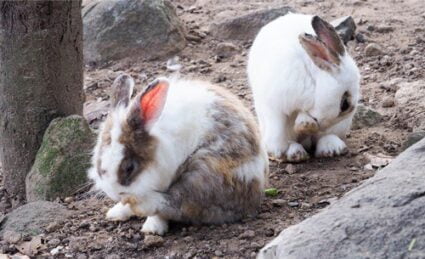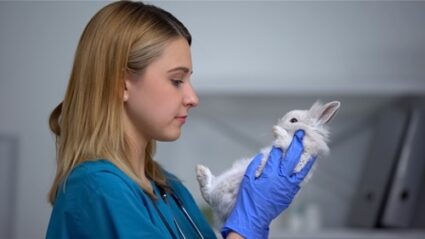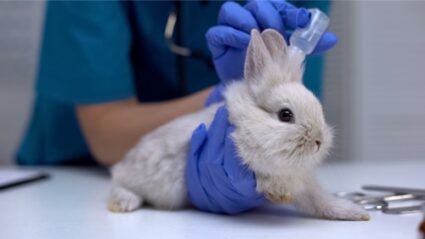If your rabbit has got fleas, she’ll be hot and itchy. She may have even damaged her skin from scratching too much. That said, you should treat the fleas to give your pet some much-needed relief.
You will need a flea-comb and a rabbit-safe flea treatment such as Imidacloprid (Advantage), Selamectin (Revolution/Stronghold), or Ivermectin (Xeno 450). Afterward, vacuum and steam clean your carpets regularly to keep fleas away from your rabbits.
Rabbits are delicate creatures and can react badly to some flea treatments. For example, Frontline (a popular flea treatment for cats) is toxic to rabbits. We’ll show you what is and isn’t safe when it comes to treating fleas in rabbits.
Do You Have to Treat Rabbit Fleas?
A common question from rabbit owners is, ‘should I give my rabbit flea treatment?’. Generally speaking, it’s not necessary to give routine flea treatments to a rabbit. However, if you see fleas in your rabbit’s fur, these must be treated immediately.
If flea eggs are ingested, the larvae can grow into tapeworms inside the rabbit’s gut, and these tapeworms can grow to 5 meters long. Also, some fleas are carriers of a deadly disease called myxomatosis. Not to mention, fleas will make your rabbit feel itchy and lethargic.
What Are Fleas?
Fleas are tiny parasites that suck on the blood of certain animals. Rabbits can catch two different types of fleas: the rabbit flea, or the common cat flea. Fleas are black/brown in color and 2mm in length. Their life cycle is as follows:
Egg – Pupa – Lava – Adult Flea
The lifecycle can last anywhere between 2 weeks and 3 months, depending on whether they find a suitable host.
Females lay around 50 eggs per day, so it doesn’t take long for an infestation to take hold. The eggs may be laid in your pet’s fur, carpet, or on soft furnishings.
How Do Rabbits Catch Fleas?
Rabbits tend to get fleas from other pets in the household. Also, if your rabbit plays outdoors, she may contract fleas from a wild rabbit or another wild animal. In theory, visitors to your home could also carry a small number of fleas on their clothing (if their pets have fleas).
Pregnant rabbits are most at risk of catching fleas due to increased blood flow. So, if you intend to breed rabbits, check your rabbits’ fur thoroughly beforehand. Provide flea treatment (if required) before your doe falls pregnant. Also, check the fur closely throughout the pregnancy.
A flea-infested mother rabbit will inevitably pass fleas on to her babies. It’s very hard to treat fleas in baby rabbits, so prevention is key.
How to Tell If a Rabbit Has Fleas
Fleas are very fast-moving, so they can be difficult to spot. In most cases, flea dirt (flea poo) is the first visible sign of a flea infestation.
Fleas produce flea dirt after they’ve sucked on an animal’s blood. The dirt looks like small black/brown flecks in the fur. To check for flea dirt, gently run a flea comb through your rabbit’s fur and place anything you suspect to be dirt on a wet paper towel. If it turns red, then it’s flea dirt. Larvae feed on flea dirt, so it’s vital to remove it from the fur.
If your rabbit has fleas, you may also notice the following symptoms:
- Itching
- Unkempt fur around the ears
- Fur loss (particularly around the ears and tail)
- Lethargy
- In severe cases, a rabbit may start to chew its tail

What to Do If Your Rabbit Has Fleas
A rabbit infested with fleas will become miserable, not to mention potentially ill. So, if your rabbit has fleas, act fast. Treating and preventing fleas is not difficult, but there are some safety risks to be aware of. Below, we’ll show you how to treat rabbit fleas in 7 manageable steps.
1) Use a Flea Comb to Inspect the Fur
The first piece of equipment you’ll need is a flea comb. This is essentially a fine-toothed comb that allows you to scrutinize your rabbit’s fur.
Start combing your rabbit’s fur in sections. Inspect the comb for fleas, flea eggs (tiny white flecks), and flea dirt. If you only find fleas (no eggs or dirt), combing your rabbit with a flea comb should be enough to keep the problem under control.
In this case, comb your rabbit’s fur thoroughly (but gently). Drown captured fleas in water. When you have finished, wash the comb thoroughly in hot water. Repeat the process twice a day.
However, if you find evidence of flea dirt and/or flea eggs, further treatment will be required.
2) Apply a Rabbit-Safe Flea Treatment
Flea treatments can be very effective, but it’s important to choose the right one. Some products can be extremely toxic to rabbits, so don’t reach for the first flea treatment that’s lying around the house. But which treatments are safe for rabbits?
Cat/Dog Flea Treatments that are Safe for Rabbits
According to The Textbook of Rabbit Medicine, available on Science Direct, effective flea treatments for rabbits include:
- Imidacloprid (called Advantage in the US)
- Selamectin (called Revolution in the US and Stronghold in the UK).
These products aren’t licensed for rabbits, but most sources agree they are an appropriate treatment for fleas in ADULT rabbits. These products cannot be given to bunnies under 4 months of age. In any case, because they are not licensed for rabbits, it’s always best to speak to your vet for advice before giving your rabbit any type of flea treatment.
Rabbit-Specific Flea Treatments
You can buy some over-the-counter flea treatments for rabbits which contain the active ingredient Ivermectin. Ivermectin is most effective for treating ticks and mites, but it has also been shown to eradicate fleas in some rabbits. These products are:
- Beaphar Anti-Parasite Spot on for rabbits and guinea gigs (sold in the UK)
- Xeno 450 – for use on rabbits, guinea pigs and ferrets (sold worldwide)
In any case, it is advisable to speak to your vet first. New products are being developed all the time and your vet may be able to prescribe a treatment that is more effective than those listed above.
3) Isolate your Pets for 24 Hours
For flea treatments to be effective, they need to be absorbed into your rabbit’s fur and skin. When flea-treating pets, it’s vital to separate them for 24 hours.
This is to ensure one pet does not lick the flea treatment off another. This would not only stop the treatment from working but could also cause severe illness.
4) Treat Other Pets for Fleas
If you have a cat or dog in the household, your rabbit’s fleas almost certainly came from them. So, provide your cat/dog with a suitable flea treatment (and isolate them for 24 hours). In fact, cats and dogs should usually be provided with routine flea treatments to keep fleas at bay.
Some flea treatments for cats (I.e. Frontline) are not suitable for rabbits. If you have a multi-pet household, it’s best to use a rabbit-safe flea treatment on your cat/dog if possible.
5) Eradicate Fleas from the Home
Once fleas have entered a household, it will be hard to eradicate them completely. However, there are some things you can do. For example:
- Vacuum your carpets regularly. Ideally, empty the vacuum cleaner after every use and place the contents in an outdoor bin.
- Steam clean your carpets once every 6 months.
- Launder your pets’ bedding regularly, as this will help to kill flea eggs.
- Change your rabbit’s bedding regularly and don’t try to reuse parts that look clean. This may mean switching to more affordable bedding.
- Don’t allow stray animals inside your home. If you enjoy feeding feral cats, do not encourage them into your home, or into any area that will be used by your pets.
If the problem doesn’t improve, you can hire a pest control company to treat your carpets annually with a substance that repels fleas.
6) Keep your Rabbit Away from Wild Animals
As mentioned, pet rabbits can catch fleas from wild animals – particularly feral cats and wild rabbits. As such, it’s best to put your bunny in a ‘run’ when she goes outdoors. Or, make sure cats and wild rabbits cannot access your garden.
7) Prevent Fleas from Returning
Once you’ve got the fleas under control, there are things you can do to prevent another infestation:
- Use a flea comb to check your rabbit’s fur at least once a week – if you can catch fleas early, you may be able to avoid using strong anti-flea medication.
- Check your rabbit is grooming herself – Self-grooming will also help to keep fleas at bay. If your rabbit has arthritis or another painful condition that stops her from grooming, she may need to be prescribed pain relief.
- Monitor your pets – Monitor the health of all your animals. If you have cats and/or dogs, consider routine flea treatments for these animals. Make sure all your pets are registered with a vet and investigate any signs of illness as soon as they arise.
- Keep Clean – Stay on-top of the vacuuming and launder your pets’ bedding regularly.
In most cases, it is not necessary to give preventative/routine flea treatments to rabbits. This is because rabbits are very sensitive and should not be overloaded with chemical treatments.
However, if fleas are a recurring problem, speak to your vet for advice. Routine treatments may be advisable in some cases, but only under the direction of a vet.

What Not to Do When Treating Rabbit Fleas
Rabbits are delicate creatures, so you must be incredibly careful when treating them for fleas. Some chemicals and products are known to cause severe reactions in rabbits, so these must be avoided.
Flea-treatments that are Toxic to Rabbits
According to The Textbook of Rabbit Medicine, Fipronil can be extremely toxic to rabbits. Fipronil is the active ingredient in several flea treatments for cats and dogs such as:
- Frontline
- TopSpot
- Fiproguard
- Flevox/
- PetArmor
Milbemycin oxime, the active ingredient in Sentinel, is also potentially toxic to rabbits.
Other ingredients that may be toxic to rabbits include permethrin and organophosphates. These are found in some flea products such as powders and washes.
The above treatments should never be given to rabbits.
Avoid Baths
Most rabbits hate baths, so they should be avoided unless necessary. If the infestation is very serious, your vet may decide to wash your rabbit. However, this is not something you should try to do at home.
Do not Use a Flea Collar
Flea collars are not good for rabbits. Most collars release too much product for a rabbit. Also, the rabbit may start to chew on the collar. Rabbits don’t have a pronounced neck so they will probably feel very uncomfortable if forced to wear a flea collar.
Be Wary of “Natural” Treatments
When we see “natural” written on a product, we tend to assume it’s OK. But be wary of “natural” flea treatments for pets. If they contain peppermint or eucalyptus, they may cause an adverse reaction in rabbits. Also, some natural flea powders contain pyrethrin, which is not safe for rabbits.
Parasites Mistaken for Fleas
Rabbits can suffer from other parasites such as mites and ticks. Mites, in particular, can sometimes be confused for fleas. According to PDSA, mites can be identified in the following ways:
Mites
Rabbits can suffer from 3 different types of mites:
- Ear mites
- Fur mites
- Sarcoptes mites (mange) – very rare
Ear mites cause the ears to become itchy and crusty and will eventually lead to an ear infection if not treated. Ear mites cause intense scratching, so they are sometimes confused with fleas.
Fur mites look like dandruff in the rabbit’s fur. They can sometimes be confused with fleas because the white flecks look like flea eggs. Fur mites can cause a rash in humans. If you think you have caught mites from your rabbit, speak to your doctor.
Mites may not always be visible to the naked eye. Often, the first sign of mites is a bald patch of fur and intense scratching.
Ivermectin-based products (such as those mentioned in step 2) can be useful for treating mites. But, as always, it’s best to seek advice from your vet first – especially if you are unsure which parasite you are dealing with.
Can Humans Get Fleas from Rabbits?
Fleas prefer to lay their eggs in fur or soft furnishings. This means they’ll usually leave humans alone – aside from the occasional bite. Flea bites are unpleasant, but they are unlikely to cause any health problems for humans.
However, as mentioned, fleas do pose a serious health risk to rabbits. This is because fleas can spread the deadly virus myxomatosis. Fleas can also cause skin infections due to overgrooming. Also, if a rabbit ingests flea larvae while grooming, the larvae can grow into a tapeworm. Not to mention how miserable flea-infested rabbits must feel.
So, to protect the welfare of your rabbit, monitor her fur daily with a flea comb. Better still, vacuum and steam clean your carpets regularly to deter fleas.

